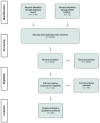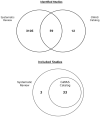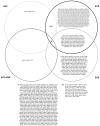Genome-wide association studies on coronary artery disease: A systematic review and implications for populations of different ancestries
- PMID: 38019802
- PMCID: PMC10686512
- DOI: 10.1371/journal.pone.0294341
Genome-wide association studies on coronary artery disease: A systematic review and implications for populations of different ancestries
Abstract
Background: Cardiovascular diseases are some of the leading causes of death worldwide, with coronary artery disease leading as one of the primary causes of mortality in both the developing and developed worlds. Despite its prevalence, there is a disproportionately small number of studies conducted in populations of non-European ancestry, with the limited sample sizes of such studies further restricting the power and generalizability of respective findings. This research aimed at understanding the differences in the genetic architecture of coronary artery disease (CAD) in populations of diverse ancestries in order to contribute towards the understanding of the pathophysiology of coronary artery disease.
Methods: We performed a systematic review on the 6th of October, 2022 summarizing genome-wide association studies on coronary artery disease, while employing the GWAS Catalog as an independent database to support the search. We developed a framework to assess the methodological quality of each study. We extracted and grouped associated single nucleotide polymorphisms and genes according to ancestry groups of participants.
Results: We identified 3100 studies, of which, 36 relevant studies were included in this research. Three of the studies that were included were not listed in the GWAS Catalog, highlighting the value of conducting an independent search alongside established databases in order to ensure the full research landscape has been captured. 743,919 CAD case participants from 25 different countries were analysed, with 61% of the studies identified in this research conducted in populations of European ancestry. No studies investigated populations of Africans living in continental Africa or admixed American ancestry groups besides African-Americans, while limited sample sizes were included of population groups besides Europeans and East Asians. This observed disproportionate population representation highlights the gaps in the literature, which limits our ability to understand coronary artery disease as a global disease. 71 genetic loci were identified to be associated with coronary artery disease in more than one article, with ancestry-specific genetic loci identified in each respective population group which were not detected in studies of other ancestries.
Conclusions: Although the replication and validation of these variants are still warranted, these finding are indicative of the value of including diverse ancestry populations in GWAS reference panels, as a more comprehensive understanding of the genetic architecture and pathophysiology of CAD can be achieved.
Copyright: © 2023 Silva et al. This is an open access article distributed under the terms of the Creative Commons Attribution License, which permits unrestricted use, distribution, and reproduction in any medium, provided the original author and source are credited.
Conflict of interest statement
The authors have declared that no competing interests exist.
Figures




Similar articles
-
Genome-wide Association Identifies Novel Etiological Insights Associated with Parkinson's Disease in African and African Admixed Populations.medRxiv [Preprint]. 2023 May 7:2023.05.05.23289529. doi: 10.1101/2023.05.05.23289529. medRxiv. 2023. Update in: Lancet Neurol. 2023 Nov;22(11):1015-1025. doi: 10.1016/S1474-4422(23)00283-1. PMID: 37398408 Free PMC article. Updated. Preprint.
-
Mendelian randomization studies on coronary artery disease: a systematic review and meta-analysis.Syst Rev. 2024 Jan 16;13(1):29. doi: 10.1186/s13643-023-02442-8. Syst Rev. 2024. PMID: 38225600 Free PMC article.
-
Identification of genetic risk loci and causal insights associated with Parkinson's disease in African and African admixed populations: a genome-wide association study.Lancet Neurol. 2023 Nov;22(11):1015-1025. doi: 10.1016/S1474-4422(23)00283-1. Epub 2023 Aug 23. Lancet Neurol. 2023. PMID: 37633302 Free PMC article.
-
Cross-ancestry genome-wide association studies identified heterogeneous loci associated with differences of allele frequency and regulome tagging between participants of European descent and other ancestry groups from the UK Biobank.Hum Mol Genet. 2021 Jul 9;30(15):1457-1467. doi: 10.1093/hmg/ddab114. Hum Mol Genet. 2021. PMID: 33890984 Free PMC article.
-
Assessing the lack of diversity in genetics research across neurodegenerative diseases: A systematic review of the GWAS Catalog and literature.Alzheimers Dement. 2024 Aug;20(8):5740-5756. doi: 10.1002/alz.13873. Epub 2024 Jun 21. Alzheimers Dement. 2024. PMID: 39030740 Free PMC article.
Cited by
-
Mitochondrial related variants associated with cardiovascular traits.Front Physiol. 2024 Aug 27;15:1395371. doi: 10.3389/fphys.2024.1395371. eCollection 2024. Front Physiol. 2024. PMID: 39258111 Free PMC article.
-
Cardiovascular Disease Burden among African Migrants.Curr Atheroscler Rep. 2025 May 30;27(1):59. doi: 10.1007/s11883-025-01307-w. Curr Atheroscler Rep. 2025. PMID: 40442399 Free PMC article. Review.
-
Next-Gen Therapeutics: Pioneering Drug Discovery with iPSCs, Genomics, AI, and Clinical Trials in a Dish.Annu Rev Pharmacol Toxicol. 2025 Jan;65(1):71-90. doi: 10.1146/annurev-pharmtox-022724-095035. Epub 2024 Dec 17. Annu Rev Pharmacol Toxicol. 2025. PMID: 39284102 Free PMC article. Review.
-
Bangladeshi Atherosclerosis Biobank and Hub: The BANGABANDHU Study.Int J Gen Med. 2024 May 28;17:2507-2512. doi: 10.2147/IJGM.S466706. eCollection 2024. Int J Gen Med. 2024. PMID: 38826511 Free PMC article.
References
Publication types
MeSH terms
Grants and funding
LinkOut - more resources
Full Text Sources
Medical
Miscellaneous

